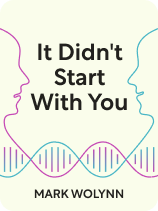

This article is an excerpt from the Shortform book guide to "It Didn't Start With You" by Mark Wolynn. Shortform has the world's best summaries and analyses of books you should be reading.
Like this article? Sign up for a free trial here .
Can you heal yourself from generational trauma? How can you root out inherited trauma once and for all?
Moving beyond childhood trauma is liberating and empowering. To do so, you can practice four healing rituals that will bring serenity into your life: visualizing positive images, mending broken relationships, planting a tree, and volunteering.
Here’s how to heal from childhood trauma, according to inherited trauma expert Mark Wolynn.
How to Move Beyond Childhood Trauma
No matter what traumas lie in your past, Mark Wolynn in his book, It Didn’t Start With You, affirms that you can break the pattern of suffering by learning how to heal from childhood trauma. Sometimes, simply making a link to traumas that happened in your family history can alleviate your most intense symptoms. But usually, a one-time breakthrough is not enough.
To achieve true, sustained healing, you must develop practices tailored to your unique circumstances that bring forward soothing emotions and physical sensations. The practices you choose, Wolynn says, should move you at a deep emotional level—powerful enough to eclipse the old, restrictive emotions and patterns that have been interfering with your freedom. Whichever rituals or practices you choose, you must repeat them regularly to cement your insights and healing.
We’ll look at some examples of healing practices Wolynn suggests you use, which we’ve separated into three categories: visualizations, mending broken relationships, and other action-oriented techniques.
1. Visualization
Here are some ways you can follow Wolynn’s recommendation to facilitate your healing through mental images:
- Place your hand on the area of your body that’s been in discomfort—maybe your chest, stomach, or head—and visualize warm, calming light flowing into that area. You can add an affirmation to deepen this experience: “At this moment I am safe.”
- Every time you look at a photo of the family member who experienced the original trauma, imagine sending them a wave of love.
- Imagine showering yourself or your family member with loving energy each time you brush your teeth or brew your coffee.
2. Mend Broken Relationships
Wolynn recommends that you use insights about past grievances to mend broken relationships. You can do this even if your family members are deceased or if you don’t know where they are. Here are some options to do this:
- Have a conversation—either in your head or out loud—with your family member addressing their particular trauma: “I know you went through great pain when your husband died of a heart attack. I have been holding that pain, which has caused me to be needy and clingy in my relationship with my husband. I am surrendering this pain back to you now. Whenever I feel insecure in my relationship, I will breathe in your love and support.”
- Express gratitude toward a parent at a level that feels authentic to you, either privately or in conversation with them. For example, you could say, “I am grateful to you for giving me life,” or “I have rejected you and blamed you for a long time. Now I am choosing to be at peace.”
- Imagine your parent saying something loving to you: “I did things to hurt you and I am sorry. Please accept the love I have for you.”
Wolynn clarifies that healing these relationships doesn’t mean excusing a parent’s behavior or resuming any kind of ongoing connection with a parent. Rather, he says, healing requires dropping the anger-filled, accusatory stories we have about our parents. Releasing those stories isn’t about giving up or giving in for the benefit of our parents. It’s about freeing ourselves so we can move forward.
3. Plant a Tree
Plant a tree to represent new life and freedom. Each time you tend it, express gratitude for your family’s support and sacrifices. (Shortform note: Gardening, in general, has many benefits, including building self-esteem, increasing your happiness, and improving cardiovascular health.)
4. Volunteer at a Charity

———End of Preview———
Like what you just read? Read the rest of the world's best book summary and analysis of Mark Wolynn's "It Didn't Start With You" at Shortform .
Here's what you'll find in our full It Didn't Start With You summary :
- A look into the causes of persistent anxiety, depression, and illness
- How the traumas of your past are stopping you from being truly happy and free
- How to resolve deeply-rooted trauma by applying a unique therapeutic approach






